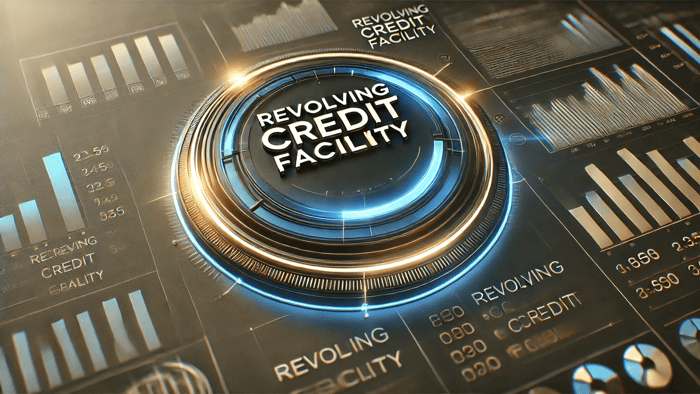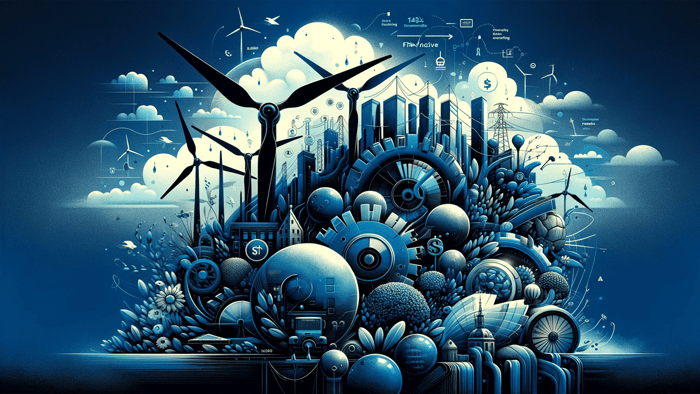In renewable energy project finance, structuring debt is crucial to optimizing a project's return and attractiveness to investors. Two commonly used financing structures are term loans and revolving credit facilities. While both provide essential funding, they differ significantly in how funds are disbursed, repaid, and managed over a project's life. This article will explore the key differences between a term loan and a revolving credit facility, using renewable energy projects as examples. Simple numeric examples will illustrate these concepts.
For a deeper dive into revolving credit facilities, check out our detailed discussion on Revolving Credit Facility in Renewable Energy Finance.
What Is a Term Loan?
A term loan is a traditional debt financing structure in which a borrower receives a lump sum upfront and repays it over a set period—usually with fixed or variable interest rates. In renewable energy projects, term loans are typically structured to match the project's cash flow profile, often sculpted to maintain an underlying target Debt Service Coverage Ratio (DSCR).
Fixed Principal Amount
Once a project's debt capacity is determined through a debt sculpting approach—which involves setting a target DSCR, defining a maximum loan tenor, and applying a maximum leverage ratio (often capped at around 80–90%)—the final debt amount is established. For projects that are already operational or undergoing refinancing, this full amount is typically disbursed in a single draw at financial close, allowing the equity sponsor to optimize returns and reduce equity exposure. In contrast, for projects under development or construction, once the project is deemed "Ready to Build" (RtB), banks commit to providing debt within a defined drawdown period. During this period, funds are made available according to a milestone payment plan, and the sponsor must usually provide evidence of incurred hard costs (e.g., payments to the EPC provider under an EPC wrap) before each drawdown.
Scheduled Repayments
Repayments for term loans may be made on a linear basis or, more commonly, sculpted to maintain a target DSCR. This means the repayment amounts are adjusted to ensure that the project’s cash flows are sufficient to cover debt service obligations—particularly during periods of lower cash flow.
DSCR Sculpting
Sculpting the repayment schedule involves aligning debt service payments with the project's actual cash flow profile. This technique helps ensure that the project's Cash Flow Available for Debt Service (CFADS) is adequate to cover debt service even when production or revenue is lower. For more details on this method, see our post on Debt Sizing with Target DSCR.
What Is a Revolving Credit Facility?
A revolving credit facility (or "revolver") provides the borrower with a credit line that can be drawn, repaid, and redrawn as needed. In project finance, the most common form of a revolver is the Debt Service Reserve Facility (DSRF), which is specifically designed to cover shortfalls in Cash Flow Available for Debt Service (CFADS) and ensure timely debt repayments. This flexibility makes DSRFs ideal for managing operational expenses, bridging cash flow gaps, or financing short-term needs during the construction phase.
Key Characteristics and Fee Structure
Flexible Access to Funds:
Funds are available on demand up to a preset credit limit.Fee Structure:
Revolvers come with a multi-layered fee structure:Upfront Fee:
A one-time fee is charged on the total credit limit.
Example: For a $1,000,000 facility with a 1.5% upfront fee, the cost is $15,000.Interest on Drawn Amounts:
Interest is charged only on the drawn funds. This is calculated as the sum of a fixed margin plus a floating base rate (e.g., EURIBOR or SOFR).
Example: If $400,000 is drawn and the interest rate is defined as a 2.0% margin plus a 3.5% base rate (total 5.5%), the annual interest on the drawn amount is approximately $22,000 ($400,000 × 5.5%).Commitment Fee on Undrawn Amounts:
A fee is charged on the undrawn portion of the facility, typically calculated as a percentage of the margin.
Example: With $600,000 undrawn on a $1,000,000 facility, and if the fee is 40% of a 2.0% margin (i.e., an effective rate of 0.8%), the annual commitment fee is about $4,800 ($600,000 × 0.8%).
For more in-depth coverage of revolving credit facilities and DSRFs, please refer to our article on Revolving Credit Facility in Renewable Energy Finance.
Comparing Term Loans and Revolving Credit Facilities
Disbursement:
- Term Loan:
Provides a lump sum upfront once debt capacity is finalized. - Revolver:
Offers a flexible line of credit, most commonly as a Debt Service Reserve Facility, which can be drawn and repaid as needed during a drawdown period.
Repayment Profile:
- Term Loan:
Repayments are structured—often sculpted—to maintain a target DSCR, aligning with the project's cash flow. - Revolver:
Repayments occur as funds are drawn and subsequently repaid, with no fixed amortization schedule, i.e., allowing for coverage of CFADS shortfalls in case of a DSRF.
Usage:
- Term Loan:
Suited for financing large capital expenditures where the entire amount is needed upfront, such as refinancing or post-construction financing. - Revolver: Ideal for managing operational expenses, bridging cash flow gaps, or, in the case of a DSRF, financing short-term financing needs by covering any shortfall in CFADS to ensure debt service obligations are met.
Practical Considerations
The optimal financing structure in renewable energy projects often combines a term loan and a revolving credit facility. A sculpted term loan is designed to match the project's long-term cash flow profile, with repayments tailored to maintain a target DSCR. Complementing this, the most common form of a revolver—a Debt Service Reserve Facility (DSRF)—covers short-term CFADS shortfalls, ensuring that scheduled debt service obligations are met even during periods of lower cash flow. In subsequent periods, any excess CFADS can be used to repay the DSRF. Depending on the sponsor's needs or bank requirements, a Debt Service Reserve Account (DSRA) or a Debt Service Reserve Letter of Credit (DSR LC) may be used instead of a DSRF, further enhancing the flexibility and resilience of the financing package.
Conclusion
Rather than choosing one financing structure over the other, integrating a sculpted term loan with a revolving credit facility (typically structured as a DSRF) creates a robust debt solution that addresses both long-term funding and short-term liquidity needs. This combination ensures that debt service payments are maintained even during cash flow fluctuations, optimizing project performance and investor appeal.
For professionals aiming to excel in renewable energy finance, our Renewables Valuation Analyst Certification Program is an invaluable resource. It provides practical training in financial modeling and debt structuring tailored to the renewable energy sector—empowering you to build effective financial models and optimize your project financing.






